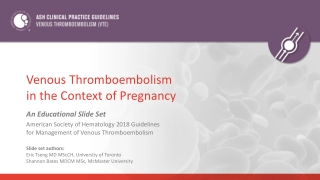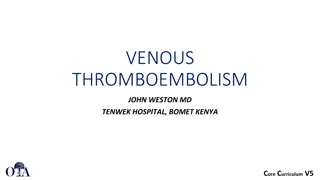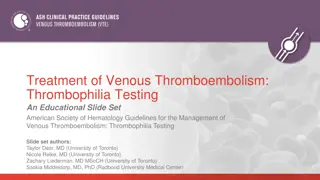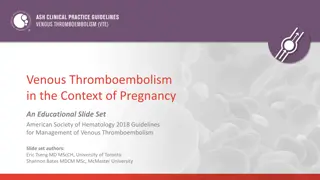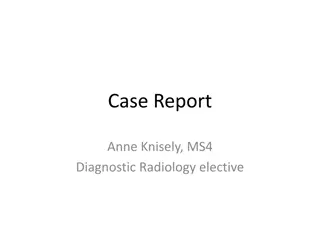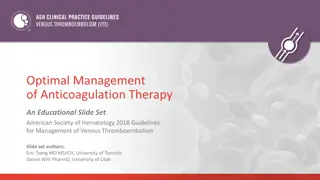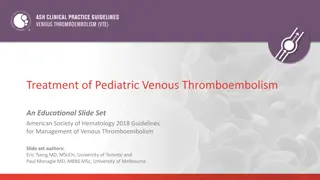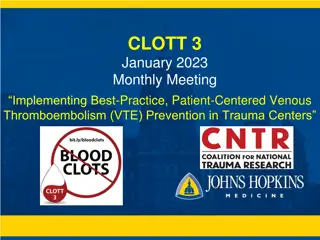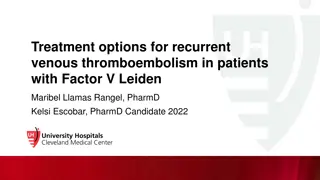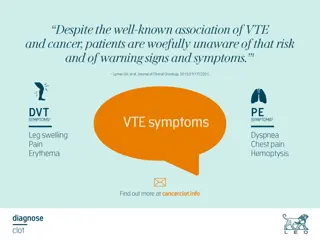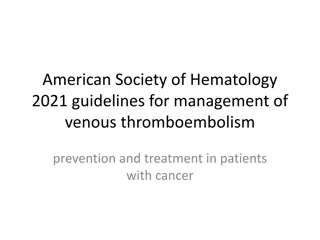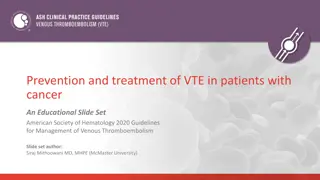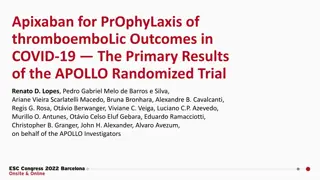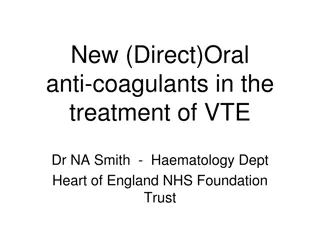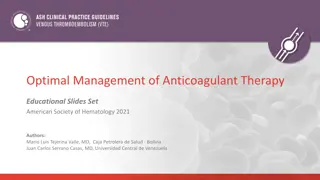
Apixaban for Cancer-Associated Venous Thromboembolism: Caravaggio Trial Overview
Explore the Caravaggio trial investigating the effectiveness of oral apixaban versus LMWH in preventing recurrent venous thromboembolism in cancer patients while minimizing major bleeding risks. Learn about the trial design, objectives, and major findings in this comprehensive overview.
Uploaded on | 0 Views
Download Presentation

Please find below an Image/Link to download the presentation.
The content on the website is provided AS IS for your information and personal use only. It may not be sold, licensed, or shared on other websites without obtaining consent from the author. If you encounter any issues during the download, it is possible that the publisher has removed the file from their server.
You are allowed to download the files provided on this website for personal or commercial use, subject to the condition that they are used lawfully. All files are the property of their respective owners.
The content on the website is provided AS IS for your information and personal use only. It may not be sold, licensed, or shared on other websites without obtaining consent from the author.
E N D
Presentation Transcript
ORIGINAL ARTICLE DR. NITHYA RAMANUJAN JUNIOR RESIDENT GENERAL MEDICINE
APIXABAN FOR THE TREATMENT OF VENOUS THROMBOEMBOLISM ASSOCIATED WITH CANCER GIANCARLO AGNELLI ET AL THE NEW ENGLAND JOURNAL OF MEDICINE March 29, 2020
INTRODUCTION Venous thromboembolism- common cause of death & complication in cancer patients. High risk of recurrent thromboembolism Vs bleeding. Hence anticoagulant treatment challenging. So specific studies involving these patients are necessary.
Major guidelines recommend the use of lowmolecular-weight heparin for the treatment of cancer-associated venous thromboembolism. Recently added the use of edoxaban or rivaroxaban(oral agents factor Xa inhibitors). Their clinical benefit- limited by a higher risk of bleeding than with LMWH. Mainly occurring at gastrointestinal sites. The oral factor Xa inhibitor apixaban- shown favourable efficacy and safety in the general population with venous thromboembolism.
OBJECTIVE Caravaggio trial To assess whether oral apixaban would be noninferior to s/c dalteparin, a LMWH, for the prevention of recurrent venous thromboembolism in patients with cancer without increasing the risk of major bleeding. SECONDARY OBJECTIVES:Apixaban Vs Dalteparin with regards to rates of: the individual components of the primary efficacy outcome symptomatic recurrence of VTE all cause death
TRIAL DESIGN Multinational, randomized, controlled, investigator-initiated, open-label, noninferiority trial with blinded adjudication of the outcomes. Patients of trial- Consecutive adults with cancer who had a newly diagnosed symptomatic or incidental proximal lower-limb DVT or PE were eligible to participate in the trial.
Criteria for diagnosis DVT- evidence of one or more filling defects at compression ultrasonography, venography, CT venography or MR venography involving at least the popliteal vein or more proximal veins. PE- one or more among: an intraluminal filling defect at CT pulmonary angiography(CTPA) an intraluminal filling defect, or a new sudden cut-off of vessels more than 2.5 mm in DM at pulmonary angiogram a perfusion defect of at least 75% of a segment with a local normal ventilation result (high probability) on ventilation/perfusion lung scan (VQ scan) in unsuspected PE, there must be one or more filling defect in segmental or more proximal arteries at chest CTPA
Inclusion Criteria 1) Consecutive patients with a newly diagnosed, objectively confirmed: symptomatic or unsuspected, proximal lower-limb DVT or symptomatic PE or unsuspected PE in a segmental or more proximal pulmonary artery. 2) Any type of cancer (other than basal-cell or squamous-cell carcinoma of the skin, primary brain tumor or known intracerebral metastases and acute leukemia) that meets at least one of the following: Active cancer -diagnosis of cancer within six months before the study inclusion, or receiving treatment for cancer at the time of inclusion or any treatment for cancer during 6 months prior to randomization, or recurrent locally advanced or metastatic cancer. History of cancer -Cancer diagnosed within 2 years before the study inclusion. 3) Signed and dated informed consent, available before the start of any specific trial procedure.
Exclusion criteria age <18 years administration of therapeutic doses of LMWH, fondaparinux, or UFH for > 72 hours before randomization 3 or more doses of a vitamin K antagonist before randomization thrombectomy, vena cava filter insertion, or thrombolysis used to manage the index episode indication for anticoagulant treatment for a disease other than the index VTE episode concomitant use of strong inhibitors or inducers of both cytochrome P-450 3A4 and P-Glycoprotein related to bleeding risk
concomitant thienopyridine therapy (clopidogrel, prasugrel, or ticagrelor) or aspirin over 165 mg daily or DAPT Hb level < 8 g/dL (5.0 mmol/L) or platelet count <75x109/L or history of heparin-induced thrombocytopenia, creatinine clearance < 30 ml /min (Cockcroft Gault equation) uncontrolled HTN (systolic BP> 180 mm Hg or diastolic BP > 100 mm Hg despite antihypertensive treatment) pregnancy or breast feeding
Randomization and Trial Intervention Eligible patients were randomly assigned in a 1:1 ratio to receive monotherapy with either apixaban or dalteparin for 6 months. The maximum proportion of patients with incidental VTE or a history of cancer was set at 20% of the overall trial population for each of the strata. Apixaban(orally) at a dose of 10 mg BD*7 days and 5 mg BD thereafter. Dalteparin(s/c) at a dose of 200 IU/KG OD*1 month f/b 150 IU/KG daily. The maximum daily dose allowed for dalteparin was 18,000 IU. The drugs could be temporarily withheld in c/o a platelet count<50,000 or any condition associated with an increased risk of bleeding, including surgery, invasive procedures, or deterioration of renal function.
OUTCOME MEASURES PRIMARY OUTCOME Objectively confirmed recurrent VTE, which included proximal DVT of the lowerlimbs (symptomatic or incidental) symptomatic DVT of the upper limbs PE (symptomatic, incidental, or fatal) occurring during the 6-month trial period
DEFINITIONS Proximal DVT- located in the popliteal or a more proximal vein. Incidental PE- involving a segmental or more proximal pulmonary artery. Symptomatic DVT- detected by imaging testing performed to confirm the suspicion of DVT. Unsuspected DVT- detected by imaging testing performed not to confirm the suspicion of DVT but for other reasons (e.g. cancer diagnosis or staging). Symptomatic PE- detected by imaging testing performed to confirm the suspicion of PE. Unsuspected PE- detected by imaging testing performed not to confirm the suspicion of PE but for other reasons (e.g. cancer diagnosis or staging).
Recurrent venous thromboembolism (VTE) Confirmed recurrent proximal DVT or PE occurring during the study treatment period, ie, the composite of: a) ipsilateral proximal DVT of the LL (symptomatic or unsuspected): A recurrent proximal DVT must be distinguished from the original thrombus by comparing serial imaging modalities (compression USG, venography, CT, or MR venography). Recurrent event requires- one or more new filling defect evident on the second imaging test not evident on the original images, or an interval imaging test clearly showing thrombus resolution; only in symptomatic patients, if the venous segment was noncompressible at randomization, a substantial increase (4 mm or more) in diameter of the thrombus during full compression. b) contralateral proximal DVT of the lower limbs (symptomatic or unsuspected): Recurrent event requires- one or more new filling defects at compression USG, venography, CT, or MR venography. Unsuspected thrombus- evident on the second imaging test and not evident on the original images. c) DVT of the upper limbs (symptomatic)- Recurrent event requires- one or more new filling defects at compression USG, venography, CT or MR venography.
d) pulmonary embolism (symptomatic or unsuspected): - Symptoms of PE + 1 or 2 or 3 or 4 1) a new intraluminal filling defect at CT pulmonary angiography 2) a new intraluminal filling defect, or an extension of an existing defect, or a new sudden cut-off of vessels more than 2.5 mm in DM at pulmonary angiogram; 3) a new perfusion defect of at least 75% of a segment with a local normal ventilation result (high probability) on ventilation/perfusion lung scan (VQ scan) 4) inconclusive CTPA, pulmonary angiography, or VQ scan evidence of a new or recurrent PE with demonstration of a new or recurrent DVT in the lower extremities by compression USG or venography.
- Fatal PE- PE based on objective diagnostic testing before death or autopsy; death where PE is the most probable cause of a sudden and unexplained death according to central adjudication. - In unsuspected PE, recurrent event requires- one or more new filling defect in segmental or more-proximal arteries at CTPAevident on the second study not appreciated on previous images or an interval study clearly showing emboli resolution.
PRINCIPAL SAFETY OUTCOME Major bleeding- acute clinically overt bleeding associated with one or more of the following: a decrease in the Hb level of at least 2g/dl a transfusion of 2 or more units of red cells bleeding occurring at a critical site (intracranial, intraspinal, intraocular, pericardial, intraarticular, intramuscular with compartment syndrome, or retroperitoneal) bleeding resulting in surgical intervention fatal bleeding all occurring during 72 hours after the last dose was administered.
SECONDARY SAFETY OUTCOMES Clinically Relevant non-major bleeding- Acute clinically overt bleeding that does not meet the criteria for major and consists of: any bleeding compromising hemodynamics spontaneous hematoma larger than 25 cm2, or 100 cm2 if there was a traumatic cause intramuscular hematoma documented by ultrasonography epistaxis or gingival bleeding requiring tamponade or other medical intervention or bleeding from venipuncture for >5 minutes hematuria that was macroscopic and was spontaneous or lasted for more than 24 hours after invasive procedures hemoptysis, hematemesis or spontaneous rectal bleeding requiring endoscopy or other medical intervention any other bleeding considered to have clinical consequences for a patient such as medical intervention
RESULTS The demographic and clinical characteristics of the patients were similar in the two treatment groups (Age, male sex, weight, platelet<1 lakh, creatinine clearance 50ml/min etc) The median duration of the assigned treatment was 178 days in the apixaban group and 175 days in the dalteparin group. Reasons for the discontinuation of a trial drug included adverse event, death, investigator decision, non compliance, other reason, cancer progression protocol violation, technical logistic problem, and withdrawal of consent.
PRIMARY EFFICACY AND SAFETY OUTCOMES The primary outcome of recurrent VTE occurred in 5.6% in the apixaban group and 7.9% in the dalteparin group. Major bleeding occurred in 3.8% in the apixaban group and in 4.0% in the dalteparin group. Major gastrointestinal bleeding occurred in 11 patients in the apixaban group and in 10 patients in the dalteparin group. Major non-gastrointestinal bleeding occurred in 11 patients in apixaban group and 13 patients in dalteparin group. There were no fatal bleeding episodes in the apixaban group and 2 in the dalteparin group.
THE TYPES OF MAJOR BLEEDING IN THE TWO GROUPS The site of fatal bleeding in dalteparin group was intracranial in 1 patient and retroperitoneal in 1 patient.
Secondary Outcomes The combined cumulative incidence of recurrent VTE or major bleeding was lower in the apixaban group compared to dalteparin group. Clinically relevant nonmajor bleeding was higher in apixaban group than dalteparin group. Major or clinically relevant non major bleeding was higher in apixaban group compared to dalteparin group.
THE SITES OF CLINICALLY RELEVANT NONMAJOR BLEEDING IN THE TWO GROUPS
Death from any cause by day 210 occurred in 135 patients (23.4%) in the apixaban group and in 153 patients (26.4%) in the dalteparin group. Most deaths were related to cancer (85.2% in the apixaban group and 88.2% in the dalteparin group). 4 deaths related to VTE in each groups. 2 deaths related to bleeding in each groups. The 2 deaths from bleeding in the apixaban group occurred more than 3 days after the discontinuation of the trial drug. In sub group analyses a significant interaction was noted between age subgroups and treatment for recurrent VTE. Adverse events in both groups were also studied. The most common adverse event was progression of cancer.
Deaths and Causes of Death at day 210 #Two fatal bleedings in apixaban occurred more than 3 days after discontinuation of the study drug(apixaban).
DISCUSSION Caravaggio trial- found that oral apixaban was noninferior to s/c dalteparin for the treatment of recurrent VTE in patients with cancer. The efficacy of apixaban was consistent with and contributes to evidence of the efficacy of direct oral anticoagulants in the treatment of VTE in cancer patients. The frequencies of major bleeding were similar with apixaban and dalteparin, including major GI bleeding. These findings with respect to bleeding are in contrast to the results of previous studies, which showed a higher incidence of bleeding with other direct oral anticoagulants than with dalteparin in a similar population.
Episodes of non major bleeding were numerically higher in the apixaban group; consistent with previous studies with direct oral anticoagulants. Bleeding episodes in the genitourinary system and upper airways were the primary reasons for the increased incidence of non major clinically relevant bleeding in the apixaban group. The trial included patients with predominantly advanced active cancer and acute symptomatic VTE. Patients with a large variety of cancer types, including approximately one third that occurred at gastrointestinal sites, were included in the trial, which was consistent with the cancer distribution in the general population. Cancers associated with high thromboembolic risk, such as lung and colorectal cancers, were well represented.
No anticancer therapy was excluded, which led to the inclusion of patients receiving a broad array of cytotoxic and biologic therapies. The frequencies of recurrent VTE and major bleeding at 6 months in patients receiving dalteparin were consistent with the results of previous studies. Episodes of recurrent VTE were numerically lower in patients in the apixaban group than in the dalteparin group because of the lower incidence of recurrent PE. As observed in other studies, the time-to-event curves appeared to diverge in this trial at about 30 days, when the dose of dalteparin was reduced. But uncertain whether this divergence suggests that continuing with the initial dose of dalteparin might have improved the efficacy of this agent, a possible benefit that must be balanced with the potential increase in bleeding.
This trial investigated the efficacy and safety of apixaban during the initial 6-month treatment of VTE in patients with cancer. Additional studies are required to assess the clinical benefit of a more extended treatment duration for VTE in these patients. In patients younger than 65 years of age, apixaban was seen to be more effective than dalteparin at preventing recurrentVTE. The apparent decrease in efficacy with increasing age that was shown in the subgroup analysis should be considered as hypothesis generating and warrants attention in future studies.
LIMITATIONS 1. Gastrointestinal bleeding was not a prespecified trial outcome; however, after the publication of results of studies of other direct anticoagulants, such bleeding emerged as a relevant safety outcome. 2. Patients with brain tumors, known cerebral metastases, or acute leukemia were not enrolled for safety reasons, so these results cannot be extrapolated to these patient groups. 3. As in the large majority of studies regarding the treatment of VTE, the sample size of this trial was powered for the primary outcome (recurrent VTE) and was not powered to make definitive conclusions about bleeding.
The favorable safety profile that was found for apixaban is in agreement with the results of previous randomized trials of this drug with respect to the treatment of VTE in the general population. Taken together, these findings may expand the proportion of patients with both cancer and VTE who would be eligible for treatment with apixaban, including patients with GI cancer. CONCLUSION Oral apixaban was noninferior to subcutaneous dalteparin for the treatment of cancer associated venous thromboembolism without an increased risk of major bleeding.

